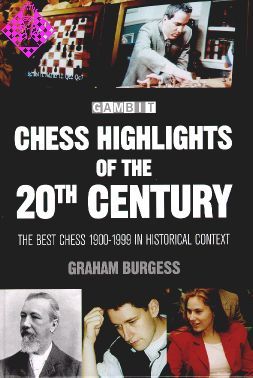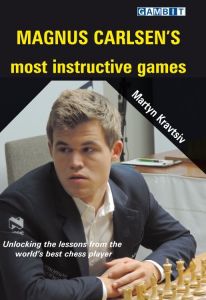Artikelnummer
LXBURCHOT20THC
Autor
Chess Highlights of the 20th Century
Best chess 1900-99 in historical context
208 Seiten, gebunden, Gambit, 1. Auflage 1999
Final vergriffen
Introduction
The aim of this book is to present a selection of the best and most entertaining chess games from the 20th Century, together with year-by-year accounts of the main chess news stories. It is intended as a book dip into both for entertaining and instruction.
Chess does not exist in a vacuum, but rather reflects and is affected by events outside our 64 squares. With this in mind, the book also contains brief accounts of the events and achievements that made world news in each year.
In selecting the chess games to include, I have sought to strike a balance between presenting the best and most important chess games, and choosing less familiar material. All the games have been carefully analysed using both carbon-based and silicon-based brains, and in many cases the new notes differ substancially in their conclusions from the 'traditional' accounts of these games. I have for the most part avoided a discussion of the opening play, and join the games in the early middlegame. This, I feel, makes the fairest comparison between different eras. How opening play has developed during the 20th Century is certainly an interesting topic, but to do it justice would require a whole book.
The chess news from each year falls into a number of broad categories. First comes the world Championship, and qualifying events for it, such as Interzonals and Candidate events. Next is news of the most important tournaments of the year, followed by team chess. In general, I have only mentioned national championships when there is something exceptional to report, such as a player becoming Champion at an unusual early age. I have made an exception for the USSR Championships, as these were such strong events as always to merit attention.
Then I discuss notable achievements in junior, women's and correspondance chess, before listening notable chess-player births and deaths. Please note that I use square brackets when referring to future events, to distinguish them from the discussion of events of the year in question, for which the present tense is used.
In the non-chess world news I have focussed on the stories that made the greatest impact on the world. Thus you will find most space devoted to sientific discoveries, inventions, conflicts, wars, disasters, social upheavals and technological breakthroughs. Naturally, I have devoted to particular attention to events that had particular influence on the chess world, such as the rise and fall of the Soviet Union. I have aimed to provide enough concise information about each key issue to assist the reader to delve deeper into particular subject.
I hope this book helps you become a better chess-player and proves to be a usefull source of chess information. Perhaps setting chess history in its wider context will even spark an interest in other areas.Graham Burgess
October 1999
The aim of this book is to present a selection of the best and most entertaining chess games from the 20th Century, together with year-by-year accounts of the main chess news stories. It is intended as a book dip into both for entertaining and instruction.
Chess does not exist in a vacuum, but rather reflects and is affected by events outside our 64 squares. With this in mind, the book also contains brief accounts of the events and achievements that made world news in each year.
In selecting the chess games to include, I have sought to strike a balance between presenting the best and most important chess games, and choosing less familiar material. All the games have been carefully analysed using both carbon-based and silicon-based brains, and in many cases the new notes differ substancially in their conclusions from the 'traditional' accounts of these games. I have for the most part avoided a discussion of the opening play, and join the games in the early middlegame. This, I feel, makes the fairest comparison between different eras. How opening play has developed during the 20th Century is certainly an interesting topic, but to do it justice would require a whole book.
The chess news from each year falls into a number of broad categories. First comes the world Championship, and qualifying events for it, such as Interzonals and Candidate events. Next is news of the most important tournaments of the year, followed by team chess. In general, I have only mentioned national championships when there is something exceptional to report, such as a player becoming Champion at an unusual early age. I have made an exception for the USSR Championships, as these were such strong events as always to merit attention.
Then I discuss notable achievements in junior, women's and correspondance chess, before listening notable chess-player births and deaths. Please note that I use square brackets when referring to future events, to distinguish them from the discussion of events of the year in question, for which the present tense is used.
In the non-chess world news I have focussed on the stories that made the greatest impact on the world. Thus you will find most space devoted to sientific discoveries, inventions, conflicts, wars, disasters, social upheavals and technological breakthroughs. Naturally, I have devoted to particular attention to events that had particular influence on the chess world, such as the rise and fall of the Soviet Union. I have aimed to provide enough concise information about each key issue to assist the reader to delve deeper into particular subject.
I hope this book helps you become a better chess-player and proves to be a usefull source of chess information. Perhaps setting chess history in its wider context will even spark an interest in other areas.Graham Burgess
October 1999
| EAN | 9781901983210 |
|---|---|
| Gewicht | 640 g |
| Hersteller | Gambit |
| Breite | 17,2 cm |
| Höhe | 25,6 cm |
| Medium | Buch |
| Erscheinungsjahr | 1999 |
| Autor | Graham Burgess |
| Sprache | Englisch |
| Auflage | 1 |
| ISBN-10 | 1901983218 |
| ISBN-13 | 9781901983210 |
| Seiten | 208 |
| Einband | gebunden |
Contents 1900 - 1919
008 Symbols and Bibliography
009 Introduction
010 1900 Tournament victories for Pillsbury, Schlechter and Lasker
012 1901 Sensational results by Capablanca
014 1902 Good results for Schlechter and Janowski
016 1903 Victories for Tarrasch and Chigorin
018 1904 Marshall triumphs at Cambridge Springs
020 1905 Great results for Tarrasch and Maroczy
022 1906 Pillsbury dies, leaving Marshall as the leading American player
024 1907 Lasker outclasses Marshall
026 1908 Lasker fends off Tarrasch's challenge
029 1909 Capablanca achieves an astonishing match victory over Marshall
030 1910 Lasker retains his world title through two (?) challenges
032 1911 Another sensational result for Capablanca
034 1912 A good year for Rubinstein
036 1913 A mixed year for Capablanca
038 1914 Lasker edges out Capablanca in the St Petersburg tournament
040 1915 No major tournaments due to the war
041 1916 The war rages on
042 1917 No major events
043 1918 International chess slowly resumes as the war ends
044 1919 Good results for Spielmann, Bogoljubow and Capablanca
Contents 1920 - 1939
045 1920 The hypermoderns make their mark
046 1921 Capablanca becomes World Champion
048 1922 Another good year for Alekhine
050 1923 Successes for Alekhine and Nimzowitsch
052 1924 Lasker triumphs at New York
054 1925 Efim Bogoljubow wins at Moscow
056 1926 A sensational result for Nimzowitsch
058 1927 Capablanca loses the World Championship to Alekhine
060 1928 An excellent year for Capablanca
062 1929 Alekhine retains the World Title
064 1930 Alekhine dominant at San Remo
066 1931 A great result for Alekhine
068 1932 A year of few major tournaments
070 1933 Botvinnik shows his class
072 1934 Alekhine remains Champion
074 1935 Alekhine loses the world title to Euwe
076 1936 Vintage performances by Capablanca
078 1937 Alekhine regains the world title
080 1938 The AVRO tournament - a triumph for Keres and Fine
082 1939 World War II throws international chess into chaos
Contents 1940 - 1959
084 1940 Chess continues in the USSR and Germany
086 1941 Botvinnik proves his 'Absolute' superiority
088 1942 Alekhine and Keres fight it out in Nazi tournaments
090 1943 Sverdlovsk becomes the centre of chess activity in the USSR
092 1944 Less chess as the war escalates
094 1945 The USSR dominates the first post - war chess matches
096 1946 Alekhine dies
098 1947 FIDE organizes new World Championship
100 1948 Botvinnik wins the World Championship
102 1949 David Bronstein emerges as a new star
104 1950 Chess and Politics mix
106 1951 A rusty Botvinnik survives Bronstein's challenge
108 1952 Excellent performances by Botvinnik, Keres and Kotov
110 1953 Smyslov triumphs at Zurich
112 1954 Botvinnik hangs on in another drawn World Championship match
114 1955 Bronstein's brilliant result
116 1956 Smyslov is the Challenger again
118 1957 Smyslov is the new World Champion
120 1958 Botvinnik regains the world title
122 1959 Tal is to challenge Botvinnik
Contents 1960 - 1979
124 1960 Tal becomes World Champion Fischer has a mixed year
126 1961 Tal becomes the youngest Ex-World Champion
128 1962 Both glory and agony for Fischer
130 1963 Petrosian defeats Botvinnik Fischer's 'exhibition'
132 1964 Spassky becomes a Candidate
134 1965 Spassky dominates the Candidates matches
136 1966 Petrosian shows his class by retaining his title
138 1967 Fischer quits the Interzonal while leading
140 1968 Spassky is to challenge again Dismay at another Fischer withdrawal
142 1969 Spassky is World Champion / Karpov - a new Soviet star
144 1970 Fischer is back on track / USSR narrowly beats the Rest of the World
146 1971 Fischer ruthless: 6-0 twice!
148 1972 Fischer is World Champion Chess is headline news around the world
150 1973 Karpov and Mecking become Candidates
152 1974 Karpov is Fischer's challenger
154 1975 Karpov becomes World Champion by default to the dismay of Fischer's fans
156 1976 Karpov proves he is a worthy Champion Korchnoi defects
158 1977 Korchnoi wins through a tempestuous Candidates cycle
160 1978 Karpov remains Champion after a thrilling match
162 1979 Garry Kasparov achieves sensational results Tal has a great year
Contents 1980 - 1999
164 1980 A mixed year for Karpov England emerges as a chess power
166 1981 Karpov comfortably defends his title
168 1982 Kasparov gathers momentum, but political storms are brewing
170 1983 Candidates cycle in crisis Kasparov faces a stern challenge from Korchnoi
172 1984 Kasparov fights desperately for survival in a marathon match
174 1985 Outrage as match is cancelled Kasparov is the new Champion
176 1986 Kasparov defends his title Startling successes by Andrei Sokolov
178 1987 Kasparov survives a scare in Seville
180 1988 The GMA makes chess more democratic and organizes the World Cup
182 1989 Kasparov wins the World Cup
184 1990 Kasparov wins an exciting match
186 1991 Anand enters the world elite The World Cup collapses
188 1992 Fischer is back Short beats Karpov
190 1993 Kasparov and Short split from FIDE
192 1994 The PCA organizes a series of high-profile events
194 1995 Kasparov retains the PCA title
196 1996 Kasparov beats Deep Blue, after losing the first game
198 1997 Kasparov loses a bizarre rematch against Deep Blue
200 1988 Anand dominates tournament chess
220 1999 Kasparov reconfirms his dominance
204 Conclusion
205 Index of Games
008 Symbols and Bibliography
009 Introduction
010 1900 Tournament victories for Pillsbury, Schlechter and Lasker
012 1901 Sensational results by Capablanca
014 1902 Good results for Schlechter and Janowski
016 1903 Victories for Tarrasch and Chigorin
018 1904 Marshall triumphs at Cambridge Springs
020 1905 Great results for Tarrasch and Maroczy
022 1906 Pillsbury dies, leaving Marshall as the leading American player
024 1907 Lasker outclasses Marshall
026 1908 Lasker fends off Tarrasch's challenge
029 1909 Capablanca achieves an astonishing match victory over Marshall
030 1910 Lasker retains his world title through two (?) challenges
032 1911 Another sensational result for Capablanca
034 1912 A good year for Rubinstein
036 1913 A mixed year for Capablanca
038 1914 Lasker edges out Capablanca in the St Petersburg tournament
040 1915 No major tournaments due to the war
041 1916 The war rages on
042 1917 No major events
043 1918 International chess slowly resumes as the war ends
044 1919 Good results for Spielmann, Bogoljubow and Capablanca
Contents 1920 - 1939
045 1920 The hypermoderns make their mark
046 1921 Capablanca becomes World Champion
048 1922 Another good year for Alekhine
050 1923 Successes for Alekhine and Nimzowitsch
052 1924 Lasker triumphs at New York
054 1925 Efim Bogoljubow wins at Moscow
056 1926 A sensational result for Nimzowitsch
058 1927 Capablanca loses the World Championship to Alekhine
060 1928 An excellent year for Capablanca
062 1929 Alekhine retains the World Title
064 1930 Alekhine dominant at San Remo
066 1931 A great result for Alekhine
068 1932 A year of few major tournaments
070 1933 Botvinnik shows his class
072 1934 Alekhine remains Champion
074 1935 Alekhine loses the world title to Euwe
076 1936 Vintage performances by Capablanca
078 1937 Alekhine regains the world title
080 1938 The AVRO tournament - a triumph for Keres and Fine
082 1939 World War II throws international chess into chaos
Contents 1940 - 1959
084 1940 Chess continues in the USSR and Germany
086 1941 Botvinnik proves his 'Absolute' superiority
088 1942 Alekhine and Keres fight it out in Nazi tournaments
090 1943 Sverdlovsk becomes the centre of chess activity in the USSR
092 1944 Less chess as the war escalates
094 1945 The USSR dominates the first post - war chess matches
096 1946 Alekhine dies
098 1947 FIDE organizes new World Championship
100 1948 Botvinnik wins the World Championship
102 1949 David Bronstein emerges as a new star
104 1950 Chess and Politics mix
106 1951 A rusty Botvinnik survives Bronstein's challenge
108 1952 Excellent performances by Botvinnik, Keres and Kotov
110 1953 Smyslov triumphs at Zurich
112 1954 Botvinnik hangs on in another drawn World Championship match
114 1955 Bronstein's brilliant result
116 1956 Smyslov is the Challenger again
118 1957 Smyslov is the new World Champion
120 1958 Botvinnik regains the world title
122 1959 Tal is to challenge Botvinnik
Contents 1960 - 1979
124 1960 Tal becomes World Champion Fischer has a mixed year
126 1961 Tal becomes the youngest Ex-World Champion
128 1962 Both glory and agony for Fischer
130 1963 Petrosian defeats Botvinnik Fischer's 'exhibition'
132 1964 Spassky becomes a Candidate
134 1965 Spassky dominates the Candidates matches
136 1966 Petrosian shows his class by retaining his title
138 1967 Fischer quits the Interzonal while leading
140 1968 Spassky is to challenge again Dismay at another Fischer withdrawal
142 1969 Spassky is World Champion / Karpov - a new Soviet star
144 1970 Fischer is back on track / USSR narrowly beats the Rest of the World
146 1971 Fischer ruthless: 6-0 twice!
148 1972 Fischer is World Champion Chess is headline news around the world
150 1973 Karpov and Mecking become Candidates
152 1974 Karpov is Fischer's challenger
154 1975 Karpov becomes World Champion by default to the dismay of Fischer's fans
156 1976 Karpov proves he is a worthy Champion Korchnoi defects
158 1977 Korchnoi wins through a tempestuous Candidates cycle
160 1978 Karpov remains Champion after a thrilling match
162 1979 Garry Kasparov achieves sensational results Tal has a great year
Contents 1980 - 1999
164 1980 A mixed year for Karpov England emerges as a chess power
166 1981 Karpov comfortably defends his title
168 1982 Kasparov gathers momentum, but political storms are brewing
170 1983 Candidates cycle in crisis Kasparov faces a stern challenge from Korchnoi
172 1984 Kasparov fights desperately for survival in a marathon match
174 1985 Outrage as match is cancelled Kasparov is the new Champion
176 1986 Kasparov defends his title Startling successes by Andrei Sokolov
178 1987 Kasparov survives a scare in Seville
180 1988 The GMA makes chess more democratic and organizes the World Cup
182 1989 Kasparov wins the World Cup
184 1990 Kasparov wins an exciting match
186 1991 Anand enters the world elite The World Cup collapses
188 1992 Fischer is back Short beats Karpov
190 1993 Kasparov and Short split from FIDE
192 1994 The PCA organizes a series of high-profile events
194 1995 Kasparov retains the PCA title
196 1996 Kasparov beats Deep Blue, after losing the first game
198 1997 Kasparov loses a bizarre rematch against Deep Blue
200 1988 Anand dominates tournament chess
220 1999 Kasparov reconfirms his dominance
204 Conclusion
205 Index of Games
Chess Highlights of the 20th Century by Graham Burgess is constructed along the following lines: two pages are devoted to each year of the 20th century, each section consisting of three or four games (or combinations) as well as a summary of the chess news and the world news of that year.
It is possible to quibble with the selection of the chess material - for example the 24th match game of Kasparov-Karpov, Sevilla 1987 does not qualify for inclusion - but I can't say that I found this too distressing (we've seen it so many times!)
I particularly enjoyed the 'Chamber of Horrors' (photos of the leading players!) As always those of Kasparov are the most revealing (I love the expression on Garry's face as Vishy plays the Centre Counter against him!).
The chronological format also reveals some bizarre things you'd never think of - for example, I was born in the same year that Tony Miles won the World Junior Championship and My System was publishhed in the same year as Mein Kampf. All in all, thoroughly enjoyable.Matthew Sadler, New in Chess Magazine 2/2000
It is possible to quibble with the selection of the chess material - for example the 24th match game of Kasparov-Karpov, Sevilla 1987 does not qualify for inclusion - but I can't say that I found this too distressing (we've seen it so many times!)
I particularly enjoyed the 'Chamber of Horrors' (photos of the leading players!) As always those of Kasparov are the most revealing (I love the expression on Garry's face as Vishy plays the Centre Counter against him!).
The chronological format also reveals some bizarre things you'd never think of - for example, I was born in the same year that Tony Miles won the World Junior Championship and My System was publishhed in the same year as Mein Kampf. All in all, thoroughly enjoyable.Matthew Sadler, New in Chess Magazine 2/2000
Die Neuerscheinung des Londoner GAMBIT - Verlages läßt die schachlichen Höhepunkte und Glanzlichter des 20. Jahrhunderts Revue passieren.
Der bekannte Autor, FM Graham Brugess, hat zu diesem Zweck berühmte (z. B. WM - Partien) und weniger geläufige Spiele ausgesucht, diese mit neuen z. T. computergestützten Analysen versehen, und in die korrekte zeitliche Reihenfolge gebracht.
Jedes Jahr von 1900 bis 1999 wird auf zwei Buchseiten abgehandelt; nach der schachlichen Jahres - Schlagzeile folgen die erwähnten Partien - meist zwei bis drei Stellungsbilder pro Jahr, zusammen neun vollständige Spiele und 274 Partiefragmente, dann folgt ein Textabschnitt mit den wichtigsten Schach-Nachrichten des Jahres (z.B. WM - Kämpfe, Schacholympiaden, bedeutende Turniere, Geburts- und Todesjahre berühmter Meister) und schließlich wird ebenfalls in aller Kürze an allgemeine Nachrichten aus aller Welt im jeweiligen Jahr erinnert, um so den zeitgeschichtlichen Zusammenhang herzustellen.
Ein Bildteil (zwischen S.128 und 129) präsentiert 39 schwarz-weiße Abbildungen bekannter Großmeister, weitere neun firmieren auf dem Cover.
Ein kurzer Blick in die mögliche Zukunft des Schachs (S. 204) sowie ein Partienverzeichnis beschließen einen mit Sorgfalt zusammengestellten Band, welcher auch in der äußerlichen Aufmachung mit Fadenheftung und Festeinband keine Wünsche offen läßt. Desgleichen konnte der Autor seinem im Vorwort geäußerten Anspruch, gleichermaßen der Belehrung und der Unterhaltung diesen zu wollen (S. 9), vollauf gerecht werden.
Trotzdem erscheint der Preis für dieses gelungene Kaleidoskop des Schach - Jahrhunderts recht üppig, zudem er ja durch den gegenwärtigen Höhenflug des britischen Pfundes noch zusätzlich gesteigert wird. Wer sich dieses wahrhaft besondere Schachbuch dennoch anschaffen möchte, sollte der englischen Sprache mächtig sein.
Dr. W. Schweizer Europa-Rochade, 04/2000
Wenn ein Jahrhundert zu Ende geht, kommt die Zeit der Rückblicke. Der britische Fide Meister Graham Burgess, bekannt durch ausgezeichnete Bücher wie z.B. einer Monographie über die Aljechin-Verteidigung, stellte sich der schwierigen Aufgabe, 100 Jahre Schach in einem einzigen Buch zusammen zu fassen.
Er widmete jedem Jahr zwei Seiten, lediglich die Jahre 1915 - 1920, in denen das Schachleben wegen des ersten Weltkrieges fast zum Erliegen gekommen war, wurden mit nur einer Seite bedacht.
Die Vorgehensweise ist dabei immer gleich: Das nach seiner Meinung Wichtigste des jeweiligen Jahres wird ausführlich anhand von Partien und zahlreichen Diagrammen besprochen, die übrigen Ereignisse werden kurz aufgezählt. Ergänzt wird jeder Jahresbericht durch Schlagzeilen aus Politik und Gesellschaft.
Herausgekommen ist dabei ein wunderschönes Schach - Lesebuch, das wir allen Schachfreunden empfehlen können. Das Buch ist durch seine ansprechende Gestaltung auch als Geschenkidee gut geeignet. Englische Sprachkenntnisse sollten vorhanden sein.
Schach-Markt 3/2000
Der bekannte Autor, FM Graham Brugess, hat zu diesem Zweck berühmte (z. B. WM - Partien) und weniger geläufige Spiele ausgesucht, diese mit neuen z. T. computergestützten Analysen versehen, und in die korrekte zeitliche Reihenfolge gebracht.
Jedes Jahr von 1900 bis 1999 wird auf zwei Buchseiten abgehandelt; nach der schachlichen Jahres - Schlagzeile folgen die erwähnten Partien - meist zwei bis drei Stellungsbilder pro Jahr, zusammen neun vollständige Spiele und 274 Partiefragmente, dann folgt ein Textabschnitt mit den wichtigsten Schach-Nachrichten des Jahres (z.B. WM - Kämpfe, Schacholympiaden, bedeutende Turniere, Geburts- und Todesjahre berühmter Meister) und schließlich wird ebenfalls in aller Kürze an allgemeine Nachrichten aus aller Welt im jeweiligen Jahr erinnert, um so den zeitgeschichtlichen Zusammenhang herzustellen.
Ein Bildteil (zwischen S.128 und 129) präsentiert 39 schwarz-weiße Abbildungen bekannter Großmeister, weitere neun firmieren auf dem Cover.
Ein kurzer Blick in die mögliche Zukunft des Schachs (S. 204) sowie ein Partienverzeichnis beschließen einen mit Sorgfalt zusammengestellten Band, welcher auch in der äußerlichen Aufmachung mit Fadenheftung und Festeinband keine Wünsche offen läßt. Desgleichen konnte der Autor seinem im Vorwort geäußerten Anspruch, gleichermaßen der Belehrung und der Unterhaltung diesen zu wollen (S. 9), vollauf gerecht werden.
Trotzdem erscheint der Preis für dieses gelungene Kaleidoskop des Schach - Jahrhunderts recht üppig, zudem er ja durch den gegenwärtigen Höhenflug des britischen Pfundes noch zusätzlich gesteigert wird. Wer sich dieses wahrhaft besondere Schachbuch dennoch anschaffen möchte, sollte der englischen Sprache mächtig sein.
Dr. W. Schweizer Europa-Rochade, 04/2000
Wenn ein Jahrhundert zu Ende geht, kommt die Zeit der Rückblicke. Der britische Fide Meister Graham Burgess, bekannt durch ausgezeichnete Bücher wie z.B. einer Monographie über die Aljechin-Verteidigung, stellte sich der schwierigen Aufgabe, 100 Jahre Schach in einem einzigen Buch zusammen zu fassen.
Er widmete jedem Jahr zwei Seiten, lediglich die Jahre 1915 - 1920, in denen das Schachleben wegen des ersten Weltkrieges fast zum Erliegen gekommen war, wurden mit nur einer Seite bedacht.
Die Vorgehensweise ist dabei immer gleich: Das nach seiner Meinung Wichtigste des jeweiligen Jahres wird ausführlich anhand von Partien und zahlreichen Diagrammen besprochen, die übrigen Ereignisse werden kurz aufgezählt. Ergänzt wird jeder Jahresbericht durch Schlagzeilen aus Politik und Gesellschaft.
Herausgekommen ist dabei ein wunderschönes Schach - Lesebuch, das wir allen Schachfreunden empfehlen können. Das Buch ist durch seine ansprechende Gestaltung auch als Geschenkidee gut geeignet. Englische Sprachkenntnisse sollten vorhanden sein.
Schach-Markt 3/2000
Mehr von Gambit
-
 Schach für Kinder15,50 €
Schach für Kinder15,50 € -
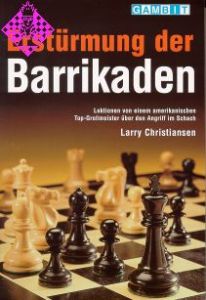 Erstürmung der Barrikaden12,95 €
Erstürmung der Barrikaden12,95 € -
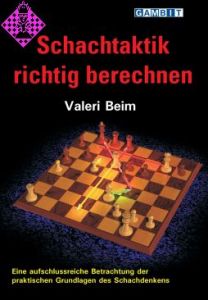 Schachtaktik richtig berechnen17,95 €
Schachtaktik richtig berechnen17,95 € -
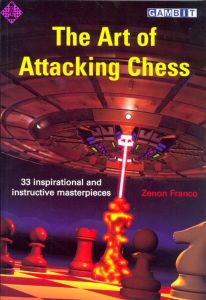 The Art of Attacking Chess11,50 €
The Art of Attacking Chess11,50 € -
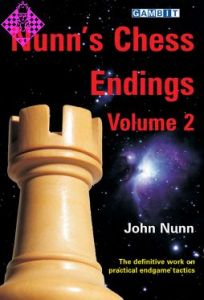 Nunn's Chess Endings - Vol. 221,50 €
Nunn's Chess Endings - Vol. 221,50 € -
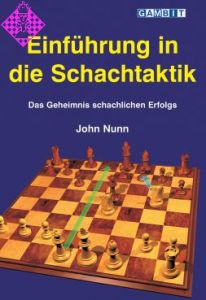 Einführung in die Schachtaktik14,95 €
Einführung in die Schachtaktik14,95 € - Mehr von Gambit

